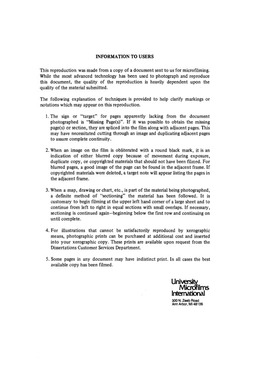| dc.contributor.author | Mccall, Rae Jean. | en_US |
| dc.date.accessioned | 2013-08-16T12:28:59Z | |
| dc.date.available | 2013-08-16T12:28:59Z | |
| dc.date.issued | 1983 | en_US |
| dc.identifier.uri | https://hdl.handle.net/11244/5183 | |
| dc.description.abstract | Ten classes of adults enrolled in formal non-credit programs of basic computer programming were involved in the study. Based upon interviews with the instructors and observation of the classes, five of the classes were identified as conforming environments and five were identified as independent environments. Students agreeing to participate in the study completed a Learning Style Inventory, a pretest, and a biographical questionnaire during the first class session. Upon completion of the sixth class session, the students were administered a posttest consisting of fifteen questions identified in the rote level of learning category and fifteen questions in the understanding level of learning category. | en_US |
| dc.description.abstract | This study was designed to determine whether or not interactions occur between/among individual differences of learners with instructional treatments. Based on the theory of experiential learning, David A. Kolb's conception of learning styles was used to identify individual differences in learners. The investigator sought to determine if individuals in different learning style categories would achieve more in certain learning environments, and if this matching would affect their ability to learn at different levels. It was expected that there would be interaction between learning style and learning environment on achievement. It was also anticipated that there would be interaction between learning style and levels of learning. Finally, it was predicted that there would be a difference between learning environments and levels of learning. | en_US |
| dc.description.abstract | The pretest and posttest instruments were computer scored and analyzed. A packaged computer system, Statistical Analysis System (SAS), was used to summarize scores and responses for each subject. Since the total number of observations produced unequal cell sizes, a table of random numbers was used to eliminate observations in each category that exceeded fifteen. A total of 120 subjects was used in the statistical analysis. | en_US |
| dc.description.abstract | It was also found that there was no difference between rote questions and understanding questions for each of the learning environments in a paired comparison t-test. | en_US |
| dc.description.abstract | An analysis of covariance (ANCOVA) revealed that learning style and learning environment do interact to affect achievement. However, a multiple analysis of covariance demonstrated that there were no differences between learning style and levels of learning. | en_US |
| dc.format.extent | xii, 74 leaves : | en_US |
| dc.subject | Education, Adult and Continuing. | en_US |
| dc.title | Effects of learning style and learning environment on achievement by levels of learning / | en_US |
| dc.type | Thesis | en_US |
| dc.thesis.degree | Ph.D. | en_US |
| dc.thesis.degreeDiscipline | Jeannine Rainbolt College of Education | en_US |
| dc.note | Source: Dissertation Abstracts International, Volume: 44-11, Section: A, page: 3246. | en_US |
| ou.identifier | (UMI)AAI8404551 | en_US |
| ou.group | Jeannine Rainbolt College of Education | |
